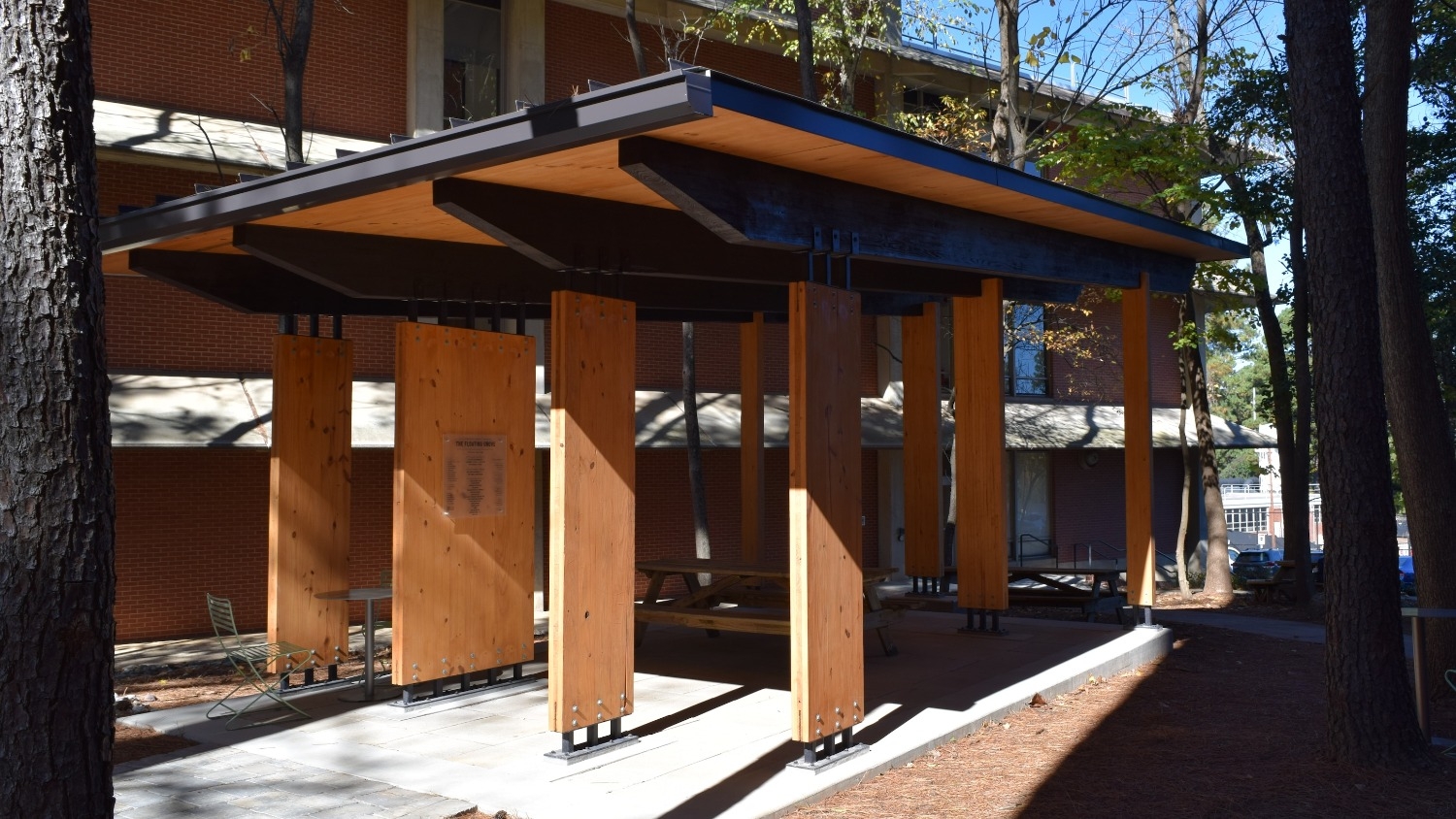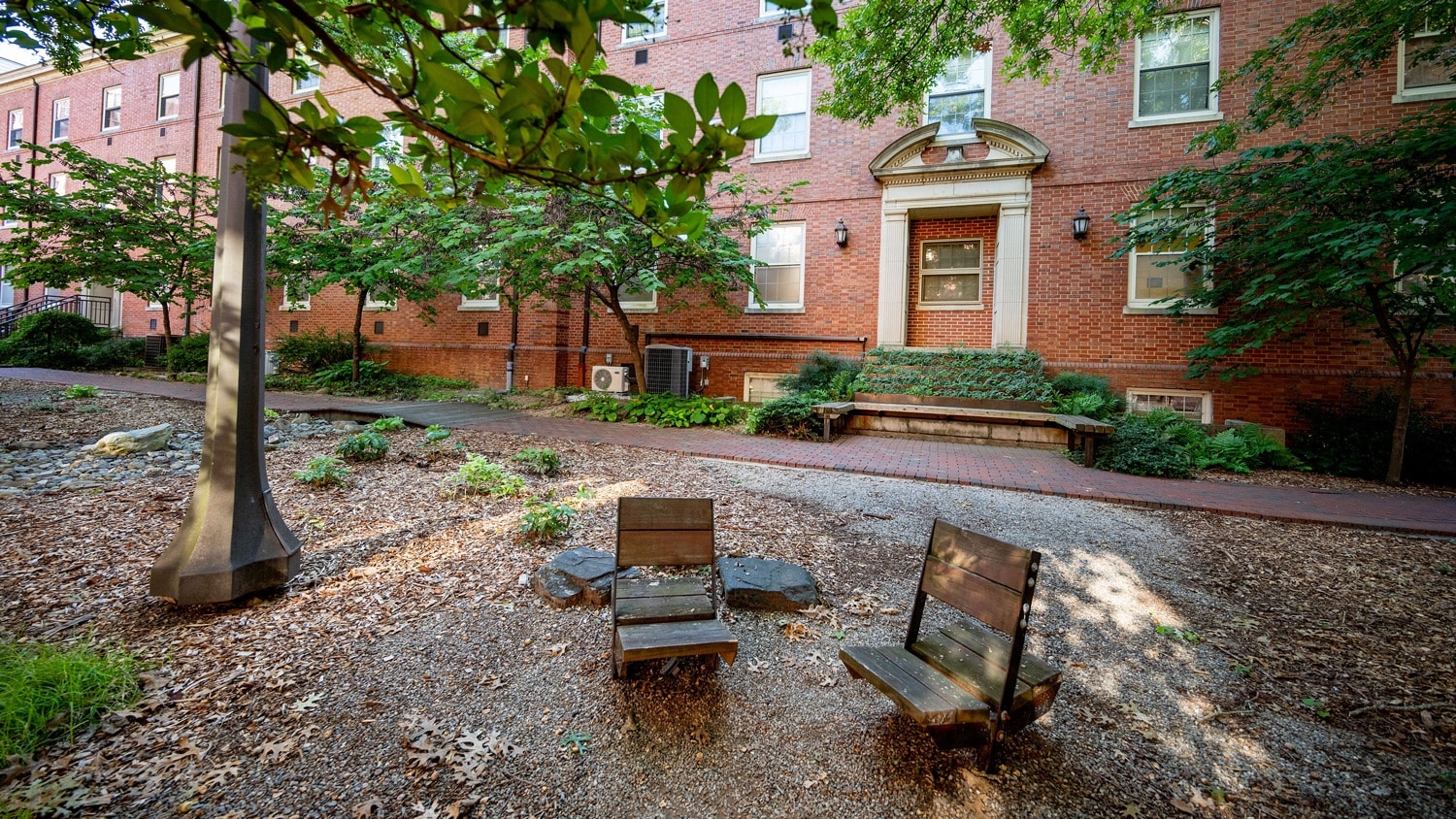Keep the Faith, Finish the Tower
There are hundreds of structures on NC State’s campus, and they all have a story to tell, some more than others. The Memorial Belltower’s story — and history — is almost hard to believe.
Alumnus Matt Robbins discovered the tower’s most ironic secret during a walk down Hillsborough Street in 2006.
He passed by the tower, just as thousands of other NC State students had before him. He heard it chime the hour — again, not out of the ordinary.
But on that day, something made the senior in communications and art studies stop and look up, closely and directly, at the top of the tower. Where he expected to see bells, he saw … nothing.
“I looked up there, and it’s straight-up empty. So tall, so sturdy, but it doesn’t include bells?” Robbins said. “It was like seeing a ring with a beautiful setting and no stone, or a lighthouse with no light.”
Indeed, the university’s most hallowed icon has existed for some 70 years since its dedication in its current form, but the tale of the tower goes back even further, and its 100-year journey to completion includes plenty of twists and turns.
Perhaps the oddest is that the tower isn’t actually complete, at least not in the way its original proponents intended when they set out to memorialize NC State alumni killed in World War I.
Almost instantly after making his discovery, Robbins began researching NC State’s Legend in Stone. He wanted to know every single thing about the structure. Why was it placed in just that spot? Who exactly were the men it honored? And shouldn’t it have bells instead of a speaker system?
Soon enough others would join in his efforts, looking for ways to highlight the site’s history and honor the original design. It would be some time before the “Finish the Belltower” project officially took off, but from that 2006 day until now, Robbins and a passionate group of amateur historians and Belltower advocates have pushed and hoped to see the university’s symbol completed.
“The tower had been there so long, people just accepted it as it was. It was so permanent that people accepted its current state as fact, and that bothered me. Why something so grand was built with something missing? That question started me on a curious search that led me in many directions over the years,” Robbins said recently, in an understatement of epic proportions when you consider the last decade-plus of his life.
Discovering an Untold History
Robbins’ interest in architecture and history had started during his time as an undergrad, well before he discovered the Belltower was without bells. He said he would see patterns in buildings and wonder why a window didn’t appear in line with others, or why bricks would change color halfway up a wall.
After being accepted into the Graduate School in 2006 to study design, Robbins’ pursuit of Belltower history intensified. He spent countless hours in the University Archives, connecting dots from decades earlier in an attempt to answer his questions.

“A lot of my time in graduate school I wasn’t in the studio, I was working on this,” he jokes.
Robbins went back to the beginning, back to the initial idea for the Belltower, which originated with a letter from 1907 graduate and Freemason Vance Sykes to the Alumni News.
Spurred by news of the death of Frank Thompson, his letter titled “To Perpetuate the Names of Heroes” proposed a fund to be started for that purpose.
Robbins studied architect William Henry Deacy, hired by the university in 1920 to design the tower. And he became an expert on the stop-and-start construction process, which began in 1921 before being halted for extended periods due to lack of funds, the Great Depression and World War II.
The stonework was completed in 1937 through the federal Works Progress Administration. The class of 1938, along with student honor societies, donated the clock and the class of 1939 bought floodlights.
After other finishing touches, including the completion of the interior Shrine Room and its memorial plaque, a formal dedication took place Nov. 11, 1949.
“When you read the letters between the architect and the committee, you can almost hear the pain about not having enough money to finish the heart of this monument,” Robbins said.
Robbins’ knowledge of the tower would become encyclopedic over time, going well beyond the historical basics. He gathered information about the tower’s connection to Freemasons across North Carolina, stumbled upon a long-lost bell on the top of Withers Hall and continues to dig — figuratively, but maybe one day literally — into the stories about a possible time capsule buried somewhere near the base of the Belltower.
All along, the thought of finishing the tower was taking root, becoming an idea that would guide years of effort.
Robbins set out to prove that the tower was always supposed to have real bells and that for it to finally be complete, a carillon should be installed in the tower belfry.
The original blueprints, which were buried away in the archives and folded into quarters, delivered the answer Robbins had been seeking.
As Robbins learned more, he began to speak, too, becoming both a Belltower historian and advocate. He even moved to Maiden Lane, living close enough that the tower’s electronic chimes would serve as a near-constant reminder of the incomplete project.
Others joined in, including Mike Thompson, a fellow alumnus with a deep interest in genealogy and military history.
“It seemed like almost no one knew there weren’t really bells,” Thompson said recently. “People just didn’t pay attention. As we started having more and more questions, it led to more and more research, so Matt and I started focusing on the Belltower together.”
Thompson’s research into the men in the tower has spanned several years and even oceans, as he visited gravesites around the United Kingdom to more fully tell the story of the NC State alumni who died in the war. Also a resident of Maiden Lane for a time, Thompson says his interest in genealogy coincided with the search for answers to Belltower mysteries.
“Matt and I got interested in the genealogy of families who had lived on Maiden Lane, and all of this kind of led to finding out more about the men in the Belltower,” Thompson said. “It’s an incredible disservice that they aren’t more publicized and well known for their sacrifices.”
Pushing for Real Bells
By 2009, Robbins and Thompson had put a name to their passion: Finish the Belltower.
And they had support from others on campus, including Jay Dawkins, NC State’s 2009 student body president and 2010 class president. Along with Dawkins, Robbins spearheaded a campaign to raise money for the installation of bells. They sold T-shirts and created a website, and Robbins spent hours building a model with a tiny carillon, showing how the tower might look when completed.
“Matt presented at a student government meeting in probably 2006 or 2007, and I remember being mesmerized by the way he talked about the Belltower,” Dawkins said. “You thought you were listening to somebody who knew the people who commissioned and initially worked on building the tower. He was such a wonderful storyteller, and it really compelled me to care about the Belltower and to care about it being completed.”
Triangle-area news outlets picked up the story, and other students and alumni joined in the effort.
Ten years ago, Robbins said he believed the fundraising effort would be the beginning of the “galvanization of the student body finishing its icon.”
The class of 2010 raised $56,000 for the biggest of the bells, a 2,000-pound behemoth destined to ring the hour note. The largest gift a senior class has given to NC State, that bell was a sign that the project had the public’s support.
Those bells were initially unveiled to the public during NC State’s 125th-anniversary celebration.
Private support helped purchase several additional bells, and there was increased interest from the public, but it would still be years before the project would come full circle.
Robbins kept the faith and kept pushing toward the ultimate goal. From the very beginning, he envisioned what a dedication day might be like. The thought of real bells ringing out for the first time motivated him throughout.
In 2017, an extraordinary gift from the Henry family as part of the university’s Think and Do the Extraordinary Campaign guaranteed that NC State’s Legend in Stone would finally be complete. Dawkins called it “amazing.”

“This is the symbol of our university, so it’s wonderful that it will finally match up to the original vision of what it should be,” he said.
The gift will support the installation of a full complement of 55 bells (purchasing those not previously spoken for), playing cabin and interior stairs. The commitment also will provide for much-needed restoration, repairs and upgrades.
Casting for the remaining bells for the new carillon began this summer at B.A. Sunderlin Bellfoundry outside Richmond, Virginia. The Belltower and surrounding plaza, which will be known as Henry Square, should be completed in late 2020 or early 2021.
The restoration will mark another chapter in the Belltower’s incredible story, one that became about so much more than bells for Robbins. Starting with his walk down Hillsborough Street and decision to look up at the tower, Robbins’ passion for history — and answering questions others may not have posed in the first place — continues to grow.
“This was about setting history right. We wanted to carry on the legacy of the people who started the Belltower and listen where no one was listening. It’s like they were directly speaking to us,” Robbins said.
Robbins listened, and that effort has helped him and others discover the full story of the Belltower.
In the end, that story is about people, both the ones the Belltower was built to honor and the ones who have helped bring the story full circle.
Soon enough, the Belltower will speak too, real bells and all.
This story is part of an ongoing series highlighting the restoration and completion of the Memorial Belltower. Follow the progress of the project and learn more about the history of NC State’s Legend in Stone.
This post was originally published in Giving News.


